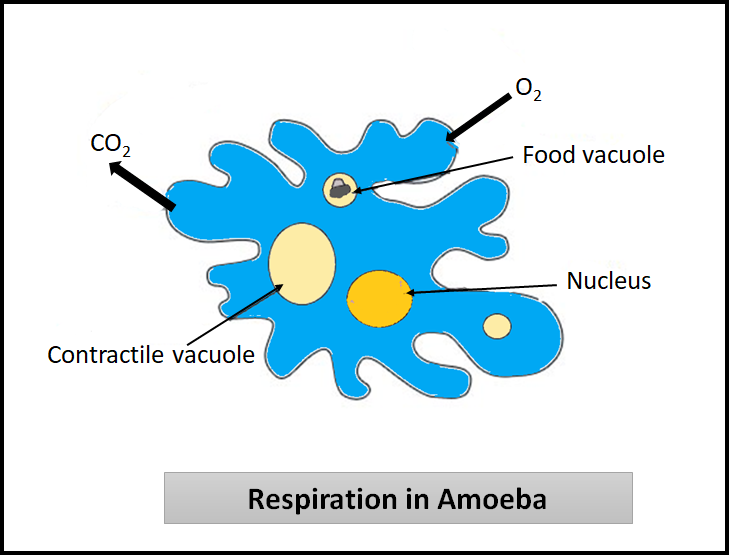
Describe the process of respiration in Amoeba. State whether it is anaerobic respiration or aerobic respiration.
Answer
489.3k+ views
Hint: Respiration is a biochemical process in which, by taking in oxygen and releasing carbon dioxide from the oxidation of complex organic compounds, the living cells of an organism generate energy. Unicellular organisms generally lack special respiratory systems. Therefore they use a simple method to obtain oxygen from the surrounding.
Complete step by step answer:
Simple diffusion occurs in unicellular organisms and it facilitates the exchange of gases across the plasma membrane. In the process, the breakdown of food occurs with or without the use of oxygen to release energy and carbon dioxide.

Respiration in amoeba occurs via the cell membrane that is also called the plasma membrane. By the mechanism of diffusion, amoeba obtains oxygen gas dissolved in surrounding water by its plasma membrane. The amoeba uses up the oxygen gas that is diffused within the body and the absorbed oxygen is used to break down the complex food material into simpler molecules. During these metabolic processes in the body of amoeba, the oxygen gas is converted into carbon dioxide gas. Also, carbon dioxide gas is released through the same diffusion process in the surrounding water.
Since amoeba requires oxygen for respiration, the type of respiration is aerobic respiration.
Additional information: Aerobic respiration is an oxygen-intensive process. In this phase, gases are exchanged. It primarily occurs in cytoplasm and mitochondria. Glucose is further broken down into water and carbon dioxide. Many of the higher species like mammals have this sort of respiration. Anaerobic respiration occurs when no oxygen is required for the process. In this form of respiration, gases are not exchanged. This can only be found in the cytoplasm. Glucose splits here into ethyl alcohol, carbon dioxide, and energy. This type of respiration is used by smaller organisms such as bacteria and yeast. This occurs in other organisms during heavy activities.
Note: Amoeba, also called an amoeboid, is a type of cell or unicellular organism that can alter its form, mainly through pseudopod extension and retraction. Amoeba is based on the easy diffusion of breathing gases. The word "amoeba" refers to simple eukaryotic species, which travel in a crawling fashion.
Complete step by step answer:
Simple diffusion occurs in unicellular organisms and it facilitates the exchange of gases across the plasma membrane. In the process, the breakdown of food occurs with or without the use of oxygen to release energy and carbon dioxide.

Respiration in amoeba occurs via the cell membrane that is also called the plasma membrane. By the mechanism of diffusion, amoeba obtains oxygen gas dissolved in surrounding water by its plasma membrane. The amoeba uses up the oxygen gas that is diffused within the body and the absorbed oxygen is used to break down the complex food material into simpler molecules. During these metabolic processes in the body of amoeba, the oxygen gas is converted into carbon dioxide gas. Also, carbon dioxide gas is released through the same diffusion process in the surrounding water.
Since amoeba requires oxygen for respiration, the type of respiration is aerobic respiration.
Additional information: Aerobic respiration is an oxygen-intensive process. In this phase, gases are exchanged. It primarily occurs in cytoplasm and mitochondria. Glucose is further broken down into water and carbon dioxide. Many of the higher species like mammals have this sort of respiration. Anaerobic respiration occurs when no oxygen is required for the process. In this form of respiration, gases are not exchanged. This can only be found in the cytoplasm. Glucose splits here into ethyl alcohol, carbon dioxide, and energy. This type of respiration is used by smaller organisms such as bacteria and yeast. This occurs in other organisms during heavy activities.
Note: Amoeba, also called an amoeboid, is a type of cell or unicellular organism that can alter its form, mainly through pseudopod extension and retraction. Amoeba is based on the easy diffusion of breathing gases. The word "amoeba" refers to simple eukaryotic species, which travel in a crawling fashion.
Recently Updated Pages
The correct geometry and hybridization for XeF4 are class 11 chemistry CBSE

Water softening by Clarks process uses ACalcium bicarbonate class 11 chemistry CBSE

With reference to graphite and diamond which of the class 11 chemistry CBSE

A certain household has consumed 250 units of energy class 11 physics CBSE

The lightest metal known is A beryllium B lithium C class 11 chemistry CBSE

What is the formula mass of the iodine molecule class 11 chemistry CBSE

Trending doubts
Is Cellular respiration an Oxidation or Reduction class 11 chemistry CBSE

In electron dot structure the valence shell electrons class 11 chemistry CBSE

What is the Pitti Island famous for ABird Sanctuary class 11 social science CBSE

State the laws of reflection of light

One Metric ton is equal to kg A 10000 B 1000 C 100 class 11 physics CBSE

Difference Between Prokaryotic Cells and Eukaryotic Cells




